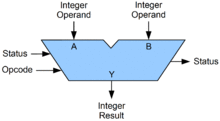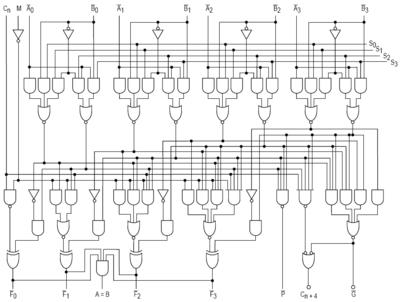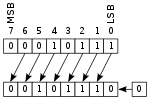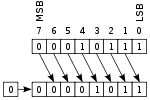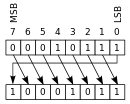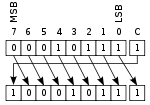
A central processing unit (CPU), also called a central processor, main processor, or just processor, is the most important processor in a given computer. Its electronic circuitry executes instructions of a computer program, such as arithmetic, logic, controlling, and input/output (I/O) operations. This role contrasts with that of external components, such as main memory and I/O circuitry, and specialized coprocessors such as graphics processing units (GPUs).

The Data General Nova is a series of 16-bit minicomputers released by the American company Data General. The Nova family was very popular in the 1970s and ultimately sold tens of thousands of units.
In digital circuits, an adder–subtractor is a circuit that is capable of adding or subtracting numbers. Below is a circuit that adds or subtracts depending on a control signal. It is also possible to construct a circuit that performs both addition and subtraction at the same time.
A shift register is a type of digital circuit using a cascade of flip-flops where the output of one flip-flop is connected to the input of the next. They share a single clock signal, which causes the data stored in the system to shift from one location to the next. By connecting the last flip-flop back to the first, the data can cycle within the shifters for extended periods, and in this configuration they were used as computer memory, displacing delay-line memory systems in the late 1960s and early 1970s.
In computer science, an instruction set architecture (ISA) is an abstract model that generally defines how software controls the CPU in a computer or a family of computers. A device or program that executes instructions described by that ISA, such as a central processing unit (CPU), is called an implementation of that ISA.

The Intel MCS-51 is a single chip microcontroller (MCU) series developed by Intel in 1980 for use in embedded systems. The architect of the Intel MCS-51 instruction set was John H. Wharton. Intel's original versions were popular in the 1980s and early 1990s, and enhanced binary compatible derivatives remain popular today. It is a complex instruction set computer, but also has some of the features of RISC architectures, such as a large register set and register windows, and has separate memory spaces for program instructions and data.

The Intel 8085 ("eighty-eighty-five") is an 8-bit microprocessor produced by Intel and introduced in March 1976. It is the last 8-bit microprocessor developed by Intel.
In computer programming, a bitwise operation operates on a bit string, a bit array or a binary numeral at the level of its individual bits. It is a fast and simple action, basic to the higher-level arithmetic operations and directly supported by the processor. Most bitwise operations are presented as two-operand instructions where the result replaces one of the input operands.
Two's complement is the most common method of representing signed integers on computers, and more generally, fixed point binary values. Two's complement uses the binary digit with the greatest place value as the sign to indicate whether the binary number is positive or negative. When the most significant bit is 1, the number is signed as negative; and when the most significant bit is 0 the number is signed as positive.

A barrel shifter is a digital circuit that can shift a data word by a specified number of bits without the use of any sequential logic, only pure combinational logic, i.e. it inherently provides a binary operation. It can however in theory also be used to implement unary operations, such as logical shift left, in cases where limited by a fixed amount. One way to implement a barrel shifter is as a sequence of multiplexers where the output of one multiplexer is connected to the input of the next multiplexer in a way that depends on the shift distance. A barrel shifter is often used to shift and rotate n-bits in modern microprocessors, typically within a single clock cycle.
In the history of computer hardware, some early reduced instruction set computer central processing units used a very similar architectural solution, now called a classic RISC pipeline. Those CPUs were: MIPS, SPARC, Motorola 88000, and later the notional CPU DLX invented for education.
An adder, or summer, is a digital circuit that performs addition of numbers. In many computers and other kinds of processors, adders are used in the arithmetic logic units (ALUs). They are also used in other parts of the processor, where they are used to calculate addresses, table indices, increment and decrement operators and similar operations.
In computing, a pipeline, also known as a data pipeline, is a set of data processing elements connected in series, where the output of one element is the input of the next one. The elements of a pipeline are often executed in parallel or in time-sliced fashion. Some amount of buffer storage is often inserted between elements.
In computer processors, the overflow flag is usually a single bit in a system status register used to indicate when an arithmetic overflow has occurred in an operation, indicating that the signed two's-complement result would not fit in the number of bits used for the result. Some architectures may be configured to automatically generate an exception on an operation resulting in overflow.
In computer processors the carry flag is a single bit in a system status register/flag register used to indicate when an arithmetic carry or borrow has been generated out of the most significant arithmetic logic unit (ALU) bit position. The carry flag enables numbers larger than a single ALU width to be added/subtracted by carrying (adding) a binary digit from a partial addition/subtraction to the least significant bit position of a more significant word. This is typically programmed by the user of the processor on the assembly or machine code level, but can also happen internally in certain processors, via digital logic or microcode, where some processors have wider registers and arithmetic instructions than ALU. It is also used to extend bit shifts and rotates in a similar manner on many processors. For subtractive operations, two (opposite) conventions are employed as most machines set the carry flag on borrow while some machines instead reset the carry flag on borrow.

The 74181 is a 4-bit slice arithmetic logic unit (ALU), implemented as a 7400 series TTL integrated circuit. Introduced by Texas Instruments in February 1970, it was the first complete ALU on a single chip. It was used as the arithmetic/logic core in the CPUs of many historically significant minicomputers and other devices.

MikroSim is an educational computer program for hardware-non-specific explanation of the general functioning and behaviour of a virtual processor, running on the Microsoft Windows operating system. Devices like miniaturized calculators, microcontroller, microprocessors, and computer can be explained on custom-developed instruction code on a register transfer level controlled by sequences of micro instructions (microcode). Based on this it is possible to develop an instruction set to control a virtual application board at higher level of abstraction.
In the C programming language, operations can be performed on a bit level using bitwise operators.
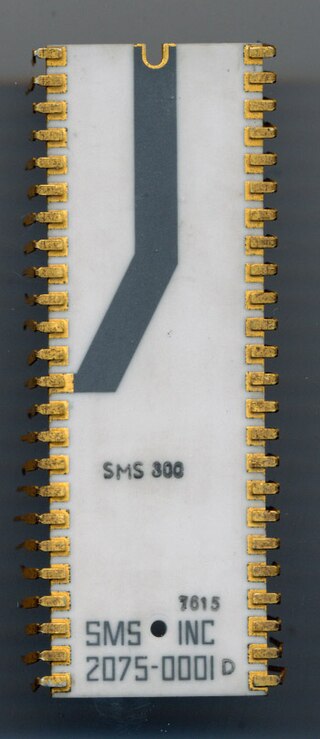
The 8X300 is a microprocessor produced and marketed by Signetics starting 1976 as a second source for the SMS 300 by Scientific Micro Systems, Inc. Although SMS developed the SMS 300, Signetics was the sole manufacturer of this product line. In 1978 Signetics purchased the rights to the SMS 300 series and renamed it 8X300.
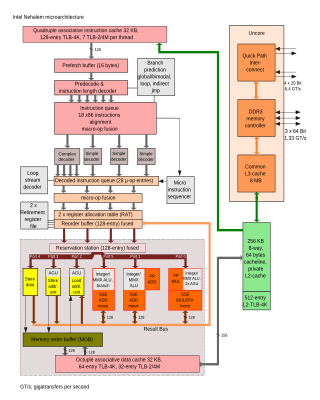
The address generation unit (AGU), sometimes also called address computation unit (ACU), is an execution unit inside central processing units (CPUs) that calculates addresses used by the CPU to access main memory. By having address calculations handled by separate circuitry that operates in parallel with the rest of the CPU, the number of CPU cycles required for executing various machine instructions can be reduced, bringing performance improvements.
